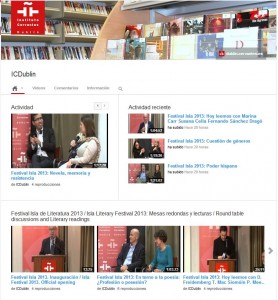Blog del Instituto Cervantes de Dublín
Torre Martello
Premio Cervantes 2011: Nicanor Parra, el maestro de la antipoesía / Cervantes Prize 2011: Nicanor Parra, master of antipoetry
El pasado 1 de diciembre se anunciaba el nombre del ganador del Premio Cervantes 2011, que este año recae merecidamente sobre Nicanor Parra. El prestigioso premio de las letras hispanas, dotado con 125.000 euros, se otorga a los escritores “cuya obra haya contribuido a enriquecer de forma notable el patrimonio literario en lengua española.“
Y éste es sin duda uno de los méritos que se pueden atribuir a Nicanor Parra, poeta chileno nacido en San Fabián de Allico en 1914, en el seno de una familia modesta. Con 21 años, mientras estudia en la Universidad de Chile, publica junto a sus compañeros Jorge Millas (escritor) y Carlos Pedraza (pintor) la Revista Nueva, y también su primer libro Cancionero sin nombre. Tras finalizar sus estudios se dedica a la docencia, en la especialidad de Física y Matemática.
En 1954 Parra publica la obra que revoluciona no solo su propio estilo, sino que crea un antes y un después en la forma de entender la poesía hispanoamericana. Poemas y antipoemas despierta la creatividad del prolífico autor chileno, que a partir de este momento desarrollará su antipoesía: “una poesía a base de hechos y no de combinaciones o figuras literarias”.
Pero más allá de la antipoesía, Parra sigue innovando, jugando con el lenguaje e incorporándole elementos visuales para engendrar los “artefactos“: poemas, eslóganes, imágenes que se funden en una crítica a una cultura vacua y consumista, manteniendo así el espíritu subversivo que acompaña toda su obra.
Desde aquí os animamos a que conozcáis la obra de Nicanor Parra (podéis encontrar algunas de sus obras en la biblioteca). Para terminar, queremos transmitir nuestra enhorabuena a Nicanor Parra por este premio, considerado el nobel de las letras hispanas, y por supuesto, por haber cumplidos los objetivos de una vida:
The last 1st December Nicanor Parra was announced as the winner of the Miguel de Cervantes Prize 2011. The famous prize of the Spanish literature is worth 125,000 Euro and is awarded to writers “whose work had contributed to remarkably enrich the literary heritage in Spanish.”
This is just one of the achievements that can be attributed to Nicanor Parra, a Chilean poet born in 1914 in a humble family in San Fabián de Allico. At age 21, while he was studying at the University of Chile, he published Revista Nueva together with the writer Jorge Millas and the painter Carlos Pedraza. The same year he published his first book, Cancionero sin nombre. After college, he started to work as a professor of Physics and Mathematics.
In 1954 Parra published a work which not only revolutionized his own style, but was also a milestone in Latin American poetry. Poemas y antipoemas stir up the creativity of this prolific author who, from that time on, started to develop his antipoetry: “a poetry based on acts, not on combinations or literary devices”.
But besides antipoetry, Parra continues innovating, playing with the language and adding visual elements in order to create the “artefacts “: poems, slogans and images melting into a criticism about our vacuous consumer society. The “artefacts” keep up the subversive style present in all his works.
We encourage you to read Nicanor Parra’s works (some titles are available in our library). Finally, we want to pass on our congratulations to Nicanor Parra for this prize, considered as the Nobel for Spanish literature, and of course, because he accomplished the objectives of a life:
(see image above)
Entradas relacionadas
Etiquetas
Antipoesía Cervantes Prize 2011 ICDublin Latin-American Writers Nicanor Parra Premio Cervantes 2011




